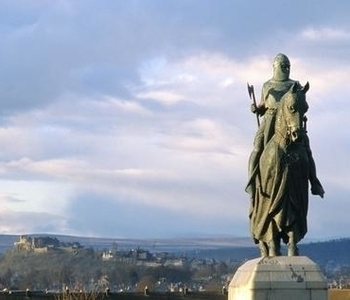The Battle of Loudoun Hill

As a proud Scot and also ex-military I am inspired by great leadership in the face of overwhelming odds, our history is long and bloodied and full of examples of heroism, and patriotism beyond question.
Leadership is something taught in most establishments around the globe, but true leadership is a quality that few possess or will ever aspire to. The ability to inspire men to walk into battle knowing they will die or at worst be taken prisoner then executed after being tortured is humbling.
The Battle of Loudoun Hill was fought between a Scots force led by King Robert the Bruce and the English commanded by Aymer de Valence, Earl of Pembroke. I’m going to tell the story of the events that led up to this battle and the battle itself.
The English prince had asked his father to allow him “raise the dragon” which means ending chivalry. Aymer de Valance the 2nd Earl of Pembroke used this to his advantage at Methven when ordered out by Robert saying it was too late in the day and would accept his challenge the following day. He then waited till dusk when the Scots were camped out and disarmed six miles away then launched an attack. This decimated the Scots and only a few knights and the king managed to make their escape. Robert lost 4000 out of 4500 men, Aymer had 600 killed or wounded.
A year later in 1307, returning from self-exile in the western isles Robert had inspired enough nobles and men to launch another attack on the English at Loudoun Hill in Ayrshire. Robert was hugely outnumbered this time, and as fate would have it, he faced Aymer de Valence. Robert had 600 men of which were pikemen and spear men against 3000. He learnt his lesson at Methven and used his and his men’s intimate knowledge of the land to his advantage including the landscapes natural defences.
He knew he could never take on the might of the English in open battle so he chose the foot of Loudon hill which to each side was boggy and unsuitable for cavalry so on the firm ground he had his men dig three trenches and mounds putting wooden spikes in the trenches to impale the cavalry as they fell in. He had his men readied in schiltrons with pike and spears. The area suitable for cavalry meant they were channelled into land 500 metres wide as they charged uphill towards the Scots.
Such was the advantage gained by Robert that the cavalry were thrown into disarray and fought with such vigor that the following soldiers started to flee in panic.
Any man irrespective of birth right who can inspire a handful of farmers and shepherds to battle against and defeat the mightiest army of the times deserves respect and gratitude.
I chose Loudon Hill as it shows how a true leader can come back from the humiliation of defeat to rise and inspire to create a glorious victory against overwhelming odds.
Written by John McCulloch, Driver-guide
